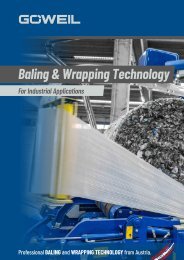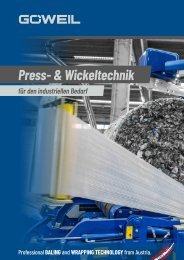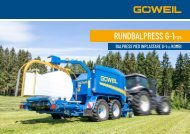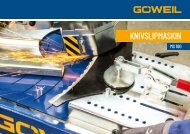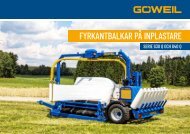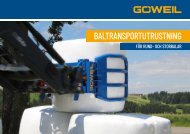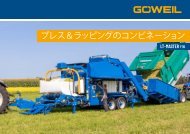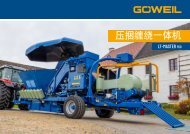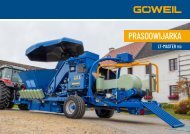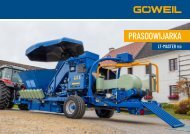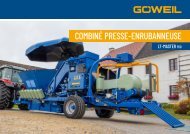Farm Machinery Journal - G-1F125 Kombi
The Farm Machinery Journal from England, pays a visit to one of our customers and talks to them about their GÖWEIL G-1 F125 Combi
The Farm Machinery Journal from England, pays a visit to one of our customers and talks to them about their GÖWEIL G-1 F125 Combi
You also want an ePaper? Increase the reach of your titles
YUMPU automatically turns print PDFs into web optimized ePapers that Google loves.
Front Link<br />
First Impression // Göweil G-1 F125 <strong>Kombi</strong><br />
pop back. It’s also much quieter and<br />
easier if you need to replace a tine,<br />
as they flex out of the way easily.”<br />
Inside the 18-roller chamber is a<br />
starter roller and above it a cleaner<br />
roller with a scraper. Richard doesn’t<br />
report any slippage in straw so the<br />
cleaner roller surface must keep it<br />
moving, the only drawback being<br />
that when working in straw the<br />
baler will roll the bale for a number<br />
of revolutions when the net is cut.<br />
“It’s not long, but all day it adds up,”<br />
Richard explains. “We’re hoping they<br />
can change the preset as it seems too<br />
long to me, but it’s only a minor thing<br />
really.<br />
Above and above<br />
right: The wrapping<br />
element is well<br />
proven, available as a<br />
frame for other balers<br />
as well as being part<br />
of development for<br />
another manufacturer<br />
Left: The Göweil can<br />
be fitted with any<br />
hitch. Adjustment for<br />
setting the drawbar<br />
to get the baler level<br />
is straightforward<br />
Above: Reloading the<br />
wrapper is a convenient<br />
job, done without lifting<br />
anything much above<br />
waist height<br />
Above centre: The chamber has a<br />
starter roller behind the rotor to<br />
get the bale turning and cleaner<br />
roller above to keep debris from<br />
clogging the other rollers<br />
“Bale density is good,” he continues.<br />
“It’ll make a good bale in pretty much<br />
any crop. We’ve made some plastic<br />
on plastic-bound bales for customers<br />
who wanted to see what they were<br />
like and the feedback has been very<br />
good.” Richard’s own bales have been<br />
very good, which has given him and<br />
Ian the confidence to recommend<br />
plastic binding to customers.<br />
Pay attention<br />
One of the few niggles Richard has<br />
found with the G-1 has been using<br />
plastic to bind the bale in dry crop.<br />
“You just have to pay attention when<br />
the film goes in,” he says. “Every now<br />
and then it won’t catch the bale and<br />
you end up not tying, which means<br />
digging the bale out if you miss it,”<br />
he continues, explaining that you<br />
can see the plastic going into the<br />
chamber on the camera and if the<br />
auto-tie misses and you spot it you<br />
can manually re-tie the bale. But, he<br />
adds, you have to be quick as the<br />
binding gets wrapped on a chamber<br />
roller. It’s not a common occurrence<br />
but in very dry grass it can happen.<br />
The wrapping element is well<br />
polished, Göweil having developed<br />
bale transfer and wrapping units for<br />
their own frame that houses other<br />
manufacturers’ balers. They have<br />
also developed the system used by<br />
another major manufacturer who<br />
offers a combi baler in this format.<br />
APRIL 2022 WWW.FARMMACHINERYJOURNAL.CO.UK




